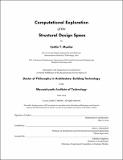Computational exploration of the structural design space
Author(s)
Mueller, Caitlin T
DownloadFull printable version (9.821Mb)
Other Contributors
Massachusetts Institute of Technology. Department of Architecture.
Advisor
John A. Ochsendorf.
Terms of use
Metadata
Show full item recordAbstract
This dissertation focuses on computational strategies for incorporating structural considerations into the earliest stages of the architectural design process. Because structural behavior is most affected by geometric form, the greatest potential for structural efficiency and a harmony of design goals occurs when global formal design decisions are made, in conceptual design. However, most existing computational tools and approaches lack the features necessary to take advantage of this potential: architectural modeling tools address geometry in absence of performance, and structural analysis tools require an already determined geometrical form. There is a need for new computational approaches that allow designers to explore the structural design space, which links geometric variation and performance, in a free and interactive manner. The dissertation addresses this need by proposing three new design space strategies. The first strategy, an interactive evolutionary framework, balances creative navigation of the design space with a focus on performance. The original contributions of this strategy center on enhanced opportunities for designer interaction and control. The second strategy introduces structural grammars, which allow for the formulation of broad and diverse design spaces that span across typologies. This strategy extends existing work in geometry-based shape grammars by incorporating structural behavior in novel ways. Finally, the third strategy is a surrogate modeling approach that approximates the design space to enable fast and responsive design environments. This strategy contributes new ways for non-experts to use this machine-learning-based methodology in conceptual design. These three complementary strategies can be applied independently or in combination, and the dissertation includes a discussion about possibilities and techniques for integrating them. Finally, the dissertation concludes by reflecting on its potential impact on design in practice, and by outlining important areas for future work. Key words: conceptual structural design, design space exploration, structural optimization, interactive evolutionary algorithm, structural grammar, surrogate modeling, structural design tools
Description
Thesis: Ph. D. in Architecture: Building Technology, Massachusetts Institute of Technology, Department of Architecture, 2014. This electronic version was submitted by the student author. The certified thesis is available in the Institute Archives and Special Collections. Cataloged from student-submitted PDF version of thesis. Includes bibliographical references (pages 199-206).
Date issued
2014Department
Massachusetts Institute of Technology. Department of ArchitecturePublisher
Massachusetts Institute of Technology
Keywords
Architecture.